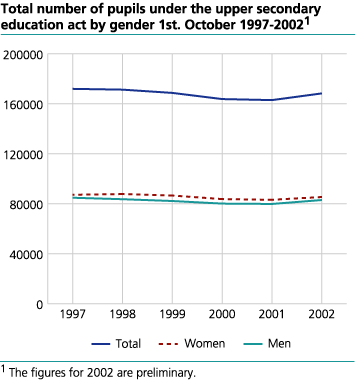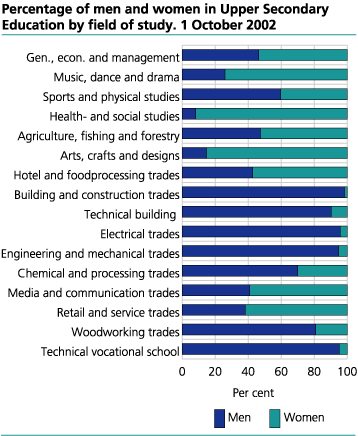Content
Published:
This is an archived release.
More pupils in vocational studies
47 per cent of the pupils in upper secondary have chosen vocational studies this school year, against 43 per cent the year before. The most popular vocational studies are Health- and social studies, Arts, crafts and designs and Engineering and mechanical trades.
Preliminary figures for school year 2002/2003 show approximately 168 000 pupils in upper secondary schools. Counties with large proportion of pupils are Hordaland, Akershus, Rogaland and Oslo. There are no major gender differences in these counties.
Increase in vocational studies
The general areas of study still have the largest share of the total number of pupils with almost 53 per cent. This is a reduction from the previous school year where the proportion was around 57 per cent.
There has however been an increase in the share of pupils within the vocational areas of study in school year 2002/2003 compared with that of the previous year from 43 per cent to 47 per cent in 2002/2003. There has been a reduction in the number of pupils in general, economic and management studies. The two new study areas- media and communication and retail and service trades had increases in the number of pupils.
Traditional gender-roles persists in choice of studies
The preliminary figures for school year 2002/2003 show that males and females are still influenced by traditional gender-roles in the choice of studies. This is especially evident in the vocational areas of studies where males comprise almost 53 per cent of the pupils.
A look at the individual areas of study reveals that females comprise as much as 92 per cent of pupils in health and social studies. This is a traditionally 'female' area of study. Likewise females are in the clear majority of those in the aesthetic areas of study. Females make up a solid 85 per cent of those in arts, crafts and design. The same applies to music, dance and drama, which is not a vocational area of study. Here females comprise 74 per cent of the pupils.
Females also dominate the two new study areas of media and communication and retail and trades with 59 and 62 per cent respectively.
Females comprise a small fraction of pupils in the more hard, and traditionally male-dominated, vocational areas of study. Males make up over 98 per cent of those in building and construction trades followed closely by electrical trades with almost 96 per cent males and engineering and mechanical trades with 95 per cent males. This trend is not so different from that of the previous school year.
Does parents' educational level influence pupil's choice of studies?
Among the total number of pupils in upper secondary schools for school year 2002/2003, approximately 55 per cent have parents with upper secondary education. Around 37 per cent have parents with tertiary education, while nearly 5.5 per cent have parents with primary and lower secondary education.
There are differences with respect to parents' educational level and areas of study. Almost 50 percent of pupils in the general areas of study that gives the right to tertiary education have parents with tertiary education and 44.5 per cent had upper secondary education. Only 3 per cent of the pupils have parents with primary and lower secondary education. The biggest difference is within music, dance and drama where 64 per cent of the pupils have parents with tertiary education whilst less than 1 per cent have parents with primary and lower secondary education.
Within the vocational areas of study 67 per cent of the pupils have parents with upper secondary education and less that 23 per cent with parents who have tertiary education and almost 8 per cent have parents with primary and lower secondary education. There is a difference with respect to media and communication studies where 47 per cent of pupils have parents with tertiary education and around 51 per cent have parents with upper secondary education.
Female majority in private schools
Around 8 600, or 5 per cent, of the pupils in upper secondary schools were in private upper secondary schools. Females accounted for almost 56 per cent of the private upper secondary education school pupils, compared with those in the public schools where approximately 50 per cent are females. The difference is more pronounced in the vocational areas of study. About 60 per cent of pupils in vocational studies in private upper secondary schools are females. The corresponding proportion in the public schools is 47 per cent.
Tables:
- Table 1 Pupils in Upper Secondary Education, by grade, gender and county of residence. 1 October 2002. Preliminary figures
- Table 2 Pupils in Upper Secondary Education, by age, gender and county of residence. 1 October 2002. Preliminary figures
- Table 3 Pupils in Upper Secondary Education, by type of education, gender and field of study. 1 October 2002. Preliminary figures
- Table 4 Pupils in Upper Secondary Education, by gender and field of study. 1 October 2002. Preliminary figures
- Table 5 Pupils in vocational study in school (VKII), by gender and field of study. 1 October 2002. Preliminary figures
- Table 6 Pupils in upper secondary education by type of subjects and parents education level. 1st October 2002. Preliminary figures
- Table 7 Pupils in upper secondary education by gender, type of subjects and ownership. October 2002. Preliminary figures
The statistics is published with Upper secondary education.
Contact
-
Statistics Norway's Information Centre
E-mail: informasjon@ssb.no
tel.: (+47) 21 09 46 42


